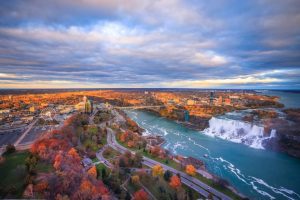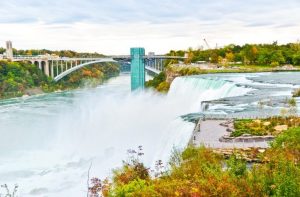 Autumn is a glorious time of year to visit Niagara Falls: The summer crowds disperse, the hotel prices drop, the warm temperatures mellow, and the lush, verdant trees turn passionate shades of red, orange, and yellow. Though the fall foliage in the Niagara region doesn’t hit its beautiful peak until about the second week of October, visits to Niagara Falls throughout the fall season will be rewarded with glimpses of the leaves aflame in autumn colors. While any time of year is the best time to visit Niagara Falls, Niagara Falls in autumn is certainly hard to beat. Here are the top five spots around Niagara Falls for excellent views of the autumn foliage:
Autumn is a glorious time of year to visit Niagara Falls: The summer crowds disperse, the hotel prices drop, the warm temperatures mellow, and the lush, verdant trees turn passionate shades of red, orange, and yellow. Though the fall foliage in the Niagara region doesn’t hit its beautiful peak until about the second week of October, visits to Niagara Falls throughout the fall season will be rewarded with glimpses of the leaves aflame in autumn colors. While any time of year is the best time to visit Niagara Falls, Niagara Falls in autumn is certainly hard to beat. Here are the top five spots around Niagara Falls for excellent views of the autumn foliage:
1. Dufferin Islands
Just a short walk from the main tourist district in Niagara Falls, Dufferin Islands Park is comprised of a series of small, man-made islands covered in flourishing forest. Quiet and serene, the park is an excellent escape from the busy walkways closer to the falls. The islands are linked by a series of quaint footbridges, and paths crisscross throughout the forest allowing visitors to explore the park for the absolute perfect spot to rest and relax.
At the start of September, the leaves on Dufferin begin to rapidly change into violent hues. The fallen leaves make excellent cushions for picnics — you might even want to bring along a bottle of Niagara wine. It is difficult to take a bad picture of Dufferin in the autumn, with the landscape so bright and beautiful.
2. Skylon Tower
While a skyscraper might not be your first instinct when you are considering places to see fall foliage, Skylon Tower is absolutely one of the best lookout spots in all of Niagara Falls. The unmissable observation deck soars 775 feet above the rushing falls, providing panoramic views of the Niagara Region, to include its changing fall leaves. From this vantage point, you can look over acres of red, orange, and yellow forest in America and Canada, as well as:
- Horseshoe, American, and Bridal Falls
- Niagara wine country
- The Great Gorge
- The Toronto and Buffalo skylines
Plus, you can visit the observation deck again at night for a completely different view, which shows the Falls themselves consumed with bright colors as well as the glittering city lights far below.
Tickets to the Skylon Tower observation deck are about $10 per adult and $6 per child. While you are in Skylon, you might also want to enjoy a meal at the outstanding revolving restaurant, which rotates to give you 360-degree views while you dine on world-class fare.
3. Goat Island
On the American side of the falls, you can take a path to Goat Island — a rather small, heavily wooded island between the two U.S. waterfalls and the Canadian Horseshoe Falls. Goat Island provides a unique vantage point, from which you can view the magnificent autumn colors of the Niagara region while taking in the thundering Falls. The walking paths around Goat Island are truly sublime, especially during the fall season; you can also explore the connected Green Island (which isn’t so green in September and October) and Luna Island, which separates Bridal Falls from American Falls. Goat Island is also home to the Cave of the Winds, where you can see the U.S. falls up close, from below.
 4. Devil’s Hole State Park
4. Devil’s Hole State Park
While you are on U.S. soil traipsing Goat Island, you should also stop by Devil’s Hole State Park. This natural park is full of the same fiery hues as the rest of Niagara in the fall, but its hiking trails tend to be less crowded than more prominent tourist spots. Like Dufferin Islands, paths crisscross the park, leading to lookouts over the Niagara Gorge, clearings with picnic benches, and even close-ups with the eponymous Devil’s Hole, which consists of whirlpools and rapids that make Niagara River outstandingly dangerous. The main trail through the park is well-tended, but it is steep, so you should bring sturdy hiking shoes and a thirst for adventure.
5. Rainbow Bridge
When you can finally pull your eyes away from the flaming foliage on the New York side, you should head back to the Ontario side using the Rainbow Bridge. Completed in 1941 — after the previous connection between Niagara Falls, New York and Niagara Falls, Ontario, the Honeymoon Bridge, collapsed due to heavy ice floes — the Rainbow Bridge is a structure internationally renowned for its architectural beauty and outstanding views. The bridge gained its memorable name almost immediately after construction began in 1939, but the name was solidified with an engraving of a passage from the Book of Genesis, which references the “bow in the cloud.”
From the bridge, you can see up the Niagara Gorge to all three waterfalls plus the iconic Niagara Falls, Ontario skyline, which includes the soaring Skylon Tower as well several top hotels. You can cross the bridge by car, bike, or foot, and the latter two give you plenty of time to take in the mixed reds, oranges, and yellows of the fall season. Currently, the toll for Rainbow Bridge is $0.50 for pedestrians and $3.75 U.S. or $4.75 Canadian for autos. It’s the best time to visit Niagara Falls, Canada, and you can tell for yourself from Rainbow Bridge.
When is the best time to visit Niagara Falls? All year-round, you can find fun and fantastic views, but in autumn, nature puts on a show. Many tourists return year after year to revel in the natural beauty of Niagara in the fall, and once you see it in person, you’ll probably want to do the same.

 4. Devil’s Hole State Park
4. Devil’s Hole State Park